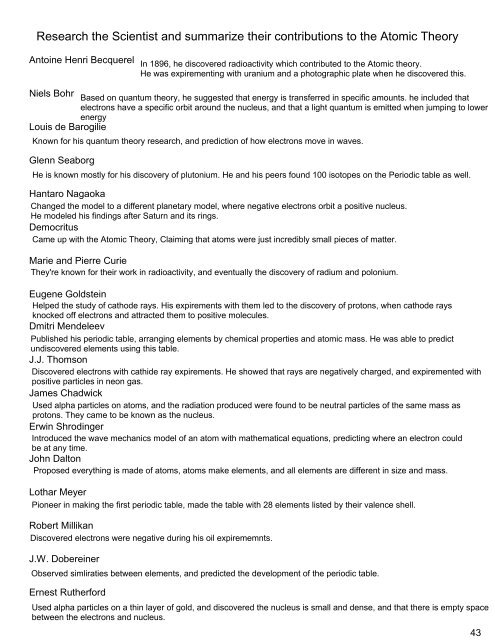Create successful ePaper yourself
Turn your PDF publications into a flip-book with our unique Google optimized e-Paper software.
Research the Scientist and summarize their contributions to the Atomic Theory<br />
Antoine Henri Becquerel<br />
In 1896, he discovered radioactivity which contributed to the Atomic theory.<br />
He was expirementing with uranium and a photographic plate when he discovered this.<br />
Niels Bohr<br />
Based on quantum theory, he suggested that energy is transferred in specific amounts. he included that<br />
electrons have a specific orbit around the nucleus, and that a light quantum is emitted when jumping to lower<br />
energy<br />
Louis de Barogilie<br />
Known for his quantum theory research, and prediction of how electrons move in waves.<br />
Glenn Seaborg<br />
He is known mostly for his discovery of plutonium. He and his peers found 100 isotopes on the Periodic table as well.<br />
Hantaro Nagaoka<br />
Changed the model to a different planetary model, where negative electrons orbit a positive nucleus.<br />
He modeled his findings after Saturn and its rings.<br />
Democritus<br />
Came up with the Atomic Theory, Claiming that atoms were just incredibly small pieces of matter.<br />
Marie and Pierre Curie<br />
They're known for their work in radioactivity, and eventually the discovery of radium and polonium.<br />
Eugene Goldstein<br />
Helped the study of cathode rays. His expirements with them led to the discovery of protons, when cathode rays<br />
knocked off electrons and attracted them to positive molecules.<br />
Dmitri Mendeleev<br />
Published his periodic table, arranging elements by chemical properties and atomic mass. He was able to predict<br />
undiscovered elements using this table.<br />
J.J. Thomson<br />
Discovered electrons with cathide ray expirements. He showed that rays are negatively charged, and expiremented with<br />
positive particles in neon gas.<br />
James Chadwick<br />
Used alpha particles on atoms, and the radiation produced were found to be neutral particles of the same mass as<br />
protons. They came to be known as the nucleus.<br />
Erwin Shrodinger<br />
Introduced the wave mechanics model of an atom with mathematical equations, predicting where an electron could<br />
be at any time.<br />
John Dalton<br />
Proposed everything is made of atoms, atoms make elements, and all elements are different in size and mass.<br />
Lothar Meyer<br />
Pioneer in making the first periodic table, made the table with 28 elements listed by their valence shell.<br />
Robert Millikan<br />
Discovered electrons were negative during his oil expirememnts.<br />
J.W. Dobereiner<br />
Observed simliraties between elements, and predicted the development of the periodic table.<br />
Ernest Rutherford<br />
Used alpha particles on a thin layer of gold, and discovered the nucleus is small and dense, and that there is empty space<br />
between the electrons and nucleus.





